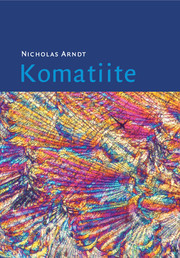Book contents
- Frontmatter
- Contents
- Preface
- Part I Background information – description of the field characteristics, mineralogy and geochemistry of komatiites
- Part II Interpretation – the manner of emplacement, the origin and the tectonic setting of komatiites
- 8 Physical properties of komatiites
- 9 Physical volcanology (by S. J. Barnes and C. M. Lesher)
- 10 Komatiite-associated Ni–Cu–PGE deposits (by C. M. Lesher and S. J. Barnes)
- 11 The hydrous komatiite hypothesis
- 12 Compositions and eruption temperatures of komatiitic liquids
- 13 Petrogenesis of komatiite
- 14 Geodynamic setting
- References
- General index
- Localities
- Plate section
9 - Physical volcanology (by S. J. Barnes and C. M. Lesher)
from Part II - Interpretation – the manner of emplacement, the origin and the tectonic setting of komatiites
Published online by Cambridge University Press: 27 August 2009
- Frontmatter
- Contents
- Preface
- Part I Background information – description of the field characteristics, mineralogy and geochemistry of komatiites
- Part II Interpretation – the manner of emplacement, the origin and the tectonic setting of komatiites
- 8 Physical properties of komatiites
- 9 Physical volcanology (by S. J. Barnes and C. M. Lesher)
- 10 Komatiite-associated Ni–Cu–PGE deposits (by C. M. Lesher and S. J. Barnes)
- 11 The hydrous komatiite hypothesis
- 12 Compositions and eruption temperatures of komatiitic liquids
- 13 Petrogenesis of komatiite
- 14 Geodynamic setting
- References
- General index
- Localities
- Plate section
Summary
Introduction
Most komatiites have been metamorphosed and deformed, and most occur in Archean greenstone belts where exposure may be locally spectacular but normally limited. Archean geology is sometimes like peering through a keyhole at tiny areas of exquisitely preserved detail, and at other times like looking down from the air through a thick ground fog. Only rarely do we have enough detailed knowledge over a large enough area to be able to obtain a clear image of komatiites at the scale of a single eruption. Understanding of komatiite volcanology must therefore be built up from a fragmentary base, by combining detailed local information with broad regional syntheses and comparisons with modern basalt flow fields. Our current state of knowledge is derived largely from areas described elsewhere in this volume, particularly the well-preserved flows of the Abitibi, Barberton and Belingwe belts (Chapters 2, 3), and the well-mineralized, markedly more olivine-rich, but generally less well-preserved flows of the eastern Yilgarn Craton (Chapter 2).
One of the challenges of komatiite research has been to relate the diversity we observe to the volcanic processes that produced it, and to construct a broadly applicable volcanological model for komatiite flow fields. The conclusions have turned out to be of great importance in understanding the origin of komatiite-associated Ni–Cu–PGE deposits (Chapter 10). They are also of great importance in unravelling the tectonic history of greenstone belts.
- Type
- Chapter
- Information
- Komatiite , pp. 243 - 294Publisher: Cambridge University PressPrint publication year: 2008



